Tennis players face a harsh reality: shoulder injuries affect up to 50% of all players. The repetitive overhead motions of serving and hitting put enormous stress on your shoulder joints and muscles. Understanding Tennis Shoulder Injury Prevention is crucial for maintaining a healthy game.
Your shoulders work overtime during every match. That makes them vulnerable to overuse injuries that can sideline you for weeks or even months.
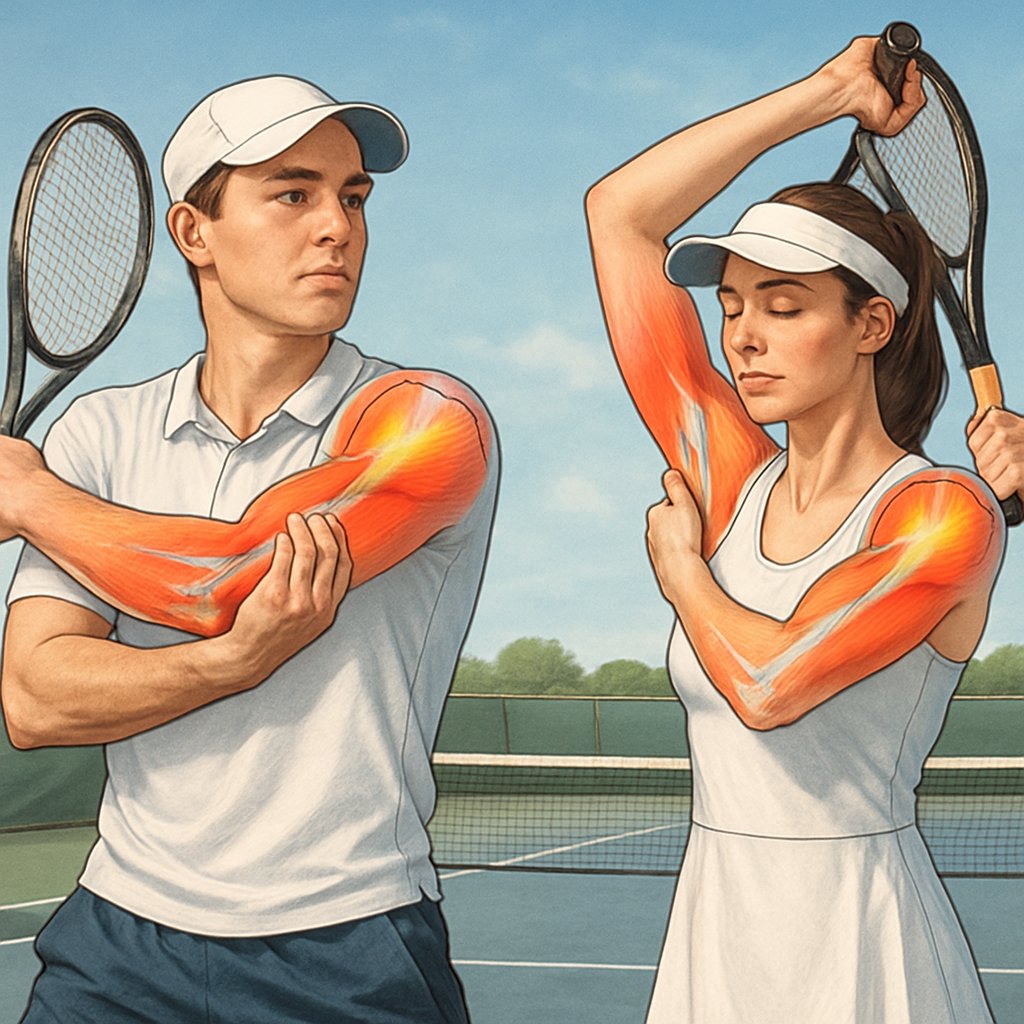
The importance of Tennis Shoulder Injury Prevention cannot be overstated. By incorporating effective strategies, you can significantly reduce your risk of injury.
Proper Tennis Shoulder Injury Prevention can keep you playing pain-free while improving your game. Most tennis shoulder injuries don’t have to happen if you take the right approach.
Implementing Tennis Shoulder Injury Prevention techniques will not only keep you pain-free but also enhance your overall performance.
Simple changes to your warm-up, technique, and conditioning can protect your shoulders. It’s not just about avoiding pain—shoulder health means more time on court and better performance.
Key Takeaways
- Tennis shoulder injuries affect up to 50% of players but are preventable with the right preparation and conditioning.
- Dynamic warm-ups, good technique, and targeted strengthening exercises are crucial for shoulder protection.
- Recognizing and managing shoulder pain early keeps minor issues from turning into serious injuries.
Understanding Shoulder Injuries in Tennis
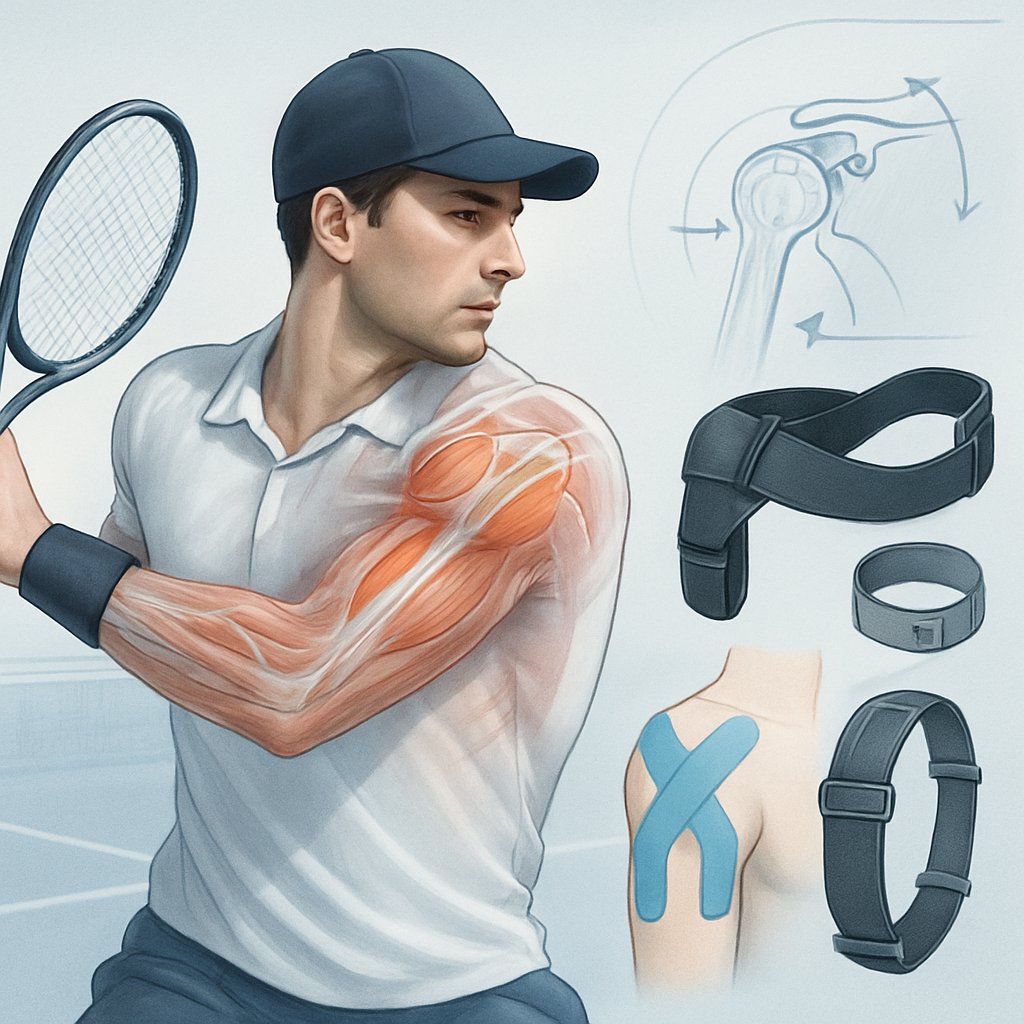
Tennis players deal with unique shoulder injury risks because of repetitive overhead movements and high-impact serves. Shoulder injuries show up in about 25-50% of tennis players, making them the most common upper body injury in the sport.
Utilizing Tennis Shoulder Injury Prevention strategies can greatly improve your play and minimize downtime.
Incorporating Tennis Shoulder Injury Prevention strategies can significantly reduce the risk of injuries and enhance your performance on the court.
Investing time in Tennis Shoulder Injury Prevention will pay dividends in your game longevity and enjoyment.
Tennis Shoulder Injury Prevention Strategies
Understanding the various methods of Tennis Shoulder Injury Prevention is essential for any serious player.
Rotator cuff injuries top the list. These four small muscles stabilize your shoulder joint during every swing and serve.
Rotator cuff strains and tears develop when these muscles get overworked. You might feel pain during overhead motions or weakness when lifting your racket.
Shoulder impingement happens when tendons get pinched between bones in your shoulder. This leads to sharp pain during serves and overhead shots.
Labral tears affect the cartilage rim around your shoulder socket. These injuries often cause deep pain and clicking sounds when you move your arm.
Biceps tendonitis means inflammation at the spot where your bicep attaches to your shoulder. Pain usually hits the front of your shoulder and gets worse with overhead activities.
Mechanisms and Causes of Shoulder Injuries
It’s vital to consider Tennis Shoulder Injury Prevention methods as part of your regular training routine to avoid common pitfalls.
Tennis serves put the most stress on your shoulders. Players can rack up about 40 serves per set, stacking up repeated strain on shoulder tissues.
The overhead motion in tennis mimics throwing. Your shoulder moves through big ranges of motion at high speed.
Repetitive stress adds up over time. Each serve and overhead shot creates micro-damage, especially if you don’t recover properly.
Poor technique ramps up injury risk. Bad serving form puts extra stress on your rotator cuff and joint.
Muscle imbalances show up when some shoulder muscles get stronger than others. This messes with movement patterns and leads to trouble.
Risk Factors for Overuse Injuries
Training volume matters—a lot. Playing more than 3-4 times a week without rest increases your chances of getting hurt.
Age and experience affect shoulder health. Older players and those with years of repetitive motion face higher injury rates.
Skipping your warm-up leaves your shoulders vulnerable. Cold muscles and joints just can’t handle sudden activity.
Weak supporting muscles around your shoulder blade and core mean less stability. Your rotator cuff has to pick up the slack.
If you’ve had a shoulder injury before, scar tissue and movement restrictions can make things worse. That history ups your risk of future problems.
Key Anatomy and Biomechanics of the Tennis Shoulder
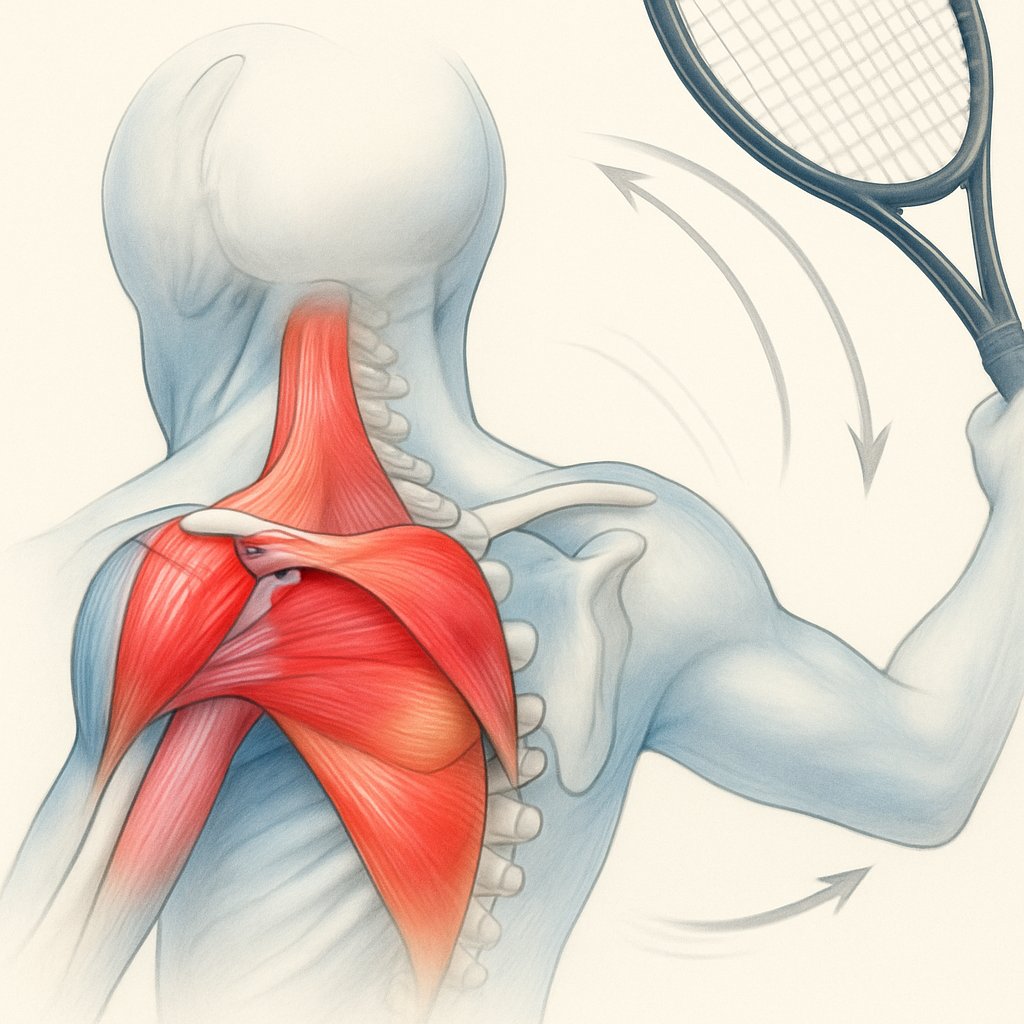
Your shoulder’s complex structure relies on multiple joints and muscles to create the power and precision tennis demands. The rotator cuff provides stability, the scapula acts as a base, and energy travels through your body via the kinetic chain.
Role of the Rotator Cuff and Glenohumeral Joint
By focusing on Tennis Shoulder Injury Prevention, players can enhance their strength and resilience on the court.
The glenohumeral joint is where your arm bone meets your shoulder socket. It’s a ball-and-socket joint that lets you swing freely.
Your rotator cuff is made up of four small muscles that wrap around the joint. They keep your arm bone centered as you move.
When you serve or hit overheads, your rotator cuff puts in extra effort. These muscles need to fire in the right order for both stability and power.
The posterior capsule at the back of your joint can get tight from all those tennis motions. This tightness leads to GIRD—glenohumeral internal rotation deficit.
GIRD happens when you lose internal rotation in your hitting arm. That imbalance increases your injury risk.
Scapula and Periscapular Muscles in Shoulder Stability
Your scapula (shoulder blade) gives your arm a stable base. It needs to move well to keep your shoulder healthy.
Periscapular muscles control scapula movement—these include the trapezius, serratus anterior, and rhomboids.
If your scapula doesn’t move right, you can end up with impingement and pain. It should glide smoothly as you lift your arm overhead.
During serves and overheads, your scapula rotates up and tilts back. This creates space for your arm to move without pinching anything.
Weak periscapular muscles let your scapula wing out from your back. That faulty movement pattern puts extra strain on your rotator cuff and capsule.
The Kinetic Chain and Energy Transfer in Tennis Strokes
The kinetic chain is how energy moves through your body during tennis strokes. Power starts at your feet and travels up to your arm.
Energy transfer works almost like a whip. Your legs create the first burst, your trunk rotates, and your shoulder brings the final acceleration.
Your shoulder is the last link in the chain. If your legs or trunk are weak or out of sync, your shoulder has to work overtime.
When the kinetic chain works well, your shoulder takes on 40-50% less stress. That’s because other body parts help generate power.
If the chain breaks down, your shoulder has to compensate. That leads to overuse injuries and, let’s be honest, worse performance.
Essential Prevention Strategies for Tennis Players
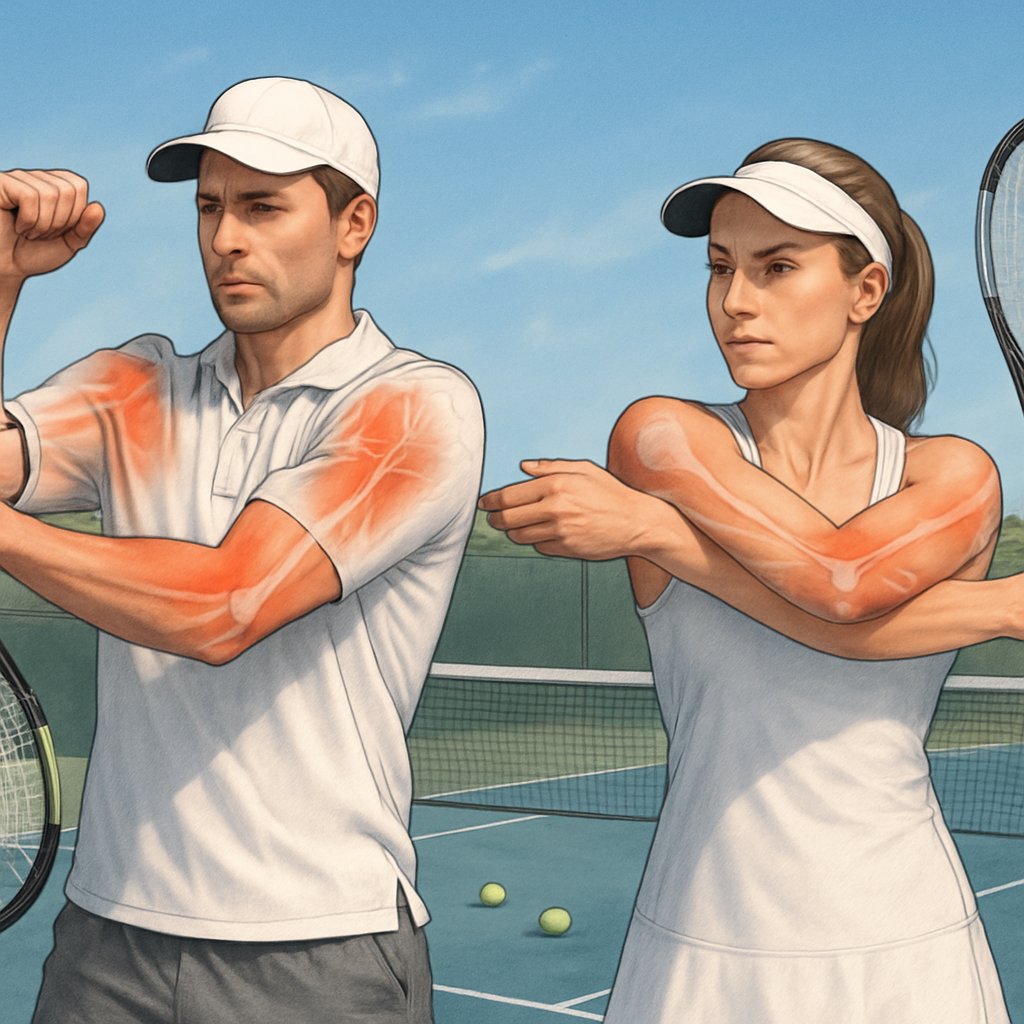
Smart prevention starts before you even hit the court. Preparation and technique work together to keep your shoulders safe from repetitive tennis stress.
Warm Up and Stretching Techniques
Incorporate Tennis Shoulder Injury Prevention practices into your warm-up to prepare your body for the demands of the game.
A solid warm-up gets your shoulders ready for tennis. Start with 5-10 minutes of light cardio—jogging or jumping jacks work well to boost blood flow.
Try these dynamic warm-up moves:
- Arm circles (forward and backward)
- Cross-body arm swings
- Shoulder blade squeezes
- Gentle overhead reaches
Mimic tennis motions with your arms, even without a racket. That gets your muscles ready for overhead work.
After warming up, do targeted shoulder stretches. Hold each for 15-30 seconds, focusing on your rotator cuff.
Cool down after playing with static stretches. This helps your muscles recover and stay flexible for next time.
Developing a Balanced Fitness and Conditioning Program
Your fitness routine should hit all the muscles that support your shoulders. Weak core and back muscles force your shoulders to pick up the slack.
Your fitness program should prioritize Tennis Shoulder Injury Prevention to ensure optimal shoulder health.
Key areas to strengthen:
- Core: planks, side planks, dead bugs
- Upper back: rows, pull-ups, reverse flies
- Rotator cuff: external rotations, band work
- Legs and glutes: squats, lunges, hip bridges
Strength train 2-3 times a week. Use resistance bands, weights, or even just your bodyweight.
Balance pushing and pulling exercises. Tennis involves lots of forward movement, so don’t forget your back muscles.
Proper Stroke Mechanics and Technique
Good technique protects your shoulders on every shot. Bad form just makes your shoulders work harder and sets you up for injury.
For overheads, use your whole body to generate power. Start with your legs and core—not just your arm.
The backhand stroke can strain shoulders if your form is off. Two-handed backhands usually put less stress on your dominant shoulder than one-handed ones.
A qualified coach can help spot problems in your form. Even small tweaks make a big difference.
Practice new technique slowly at first. Build up to full speed as it starts to feel natural.
Advanced Shoulder Conditioning and Strengthening
Advanced conditioning should always consider Tennis Shoulder Injury Prevention techniques to build a strong foundation.
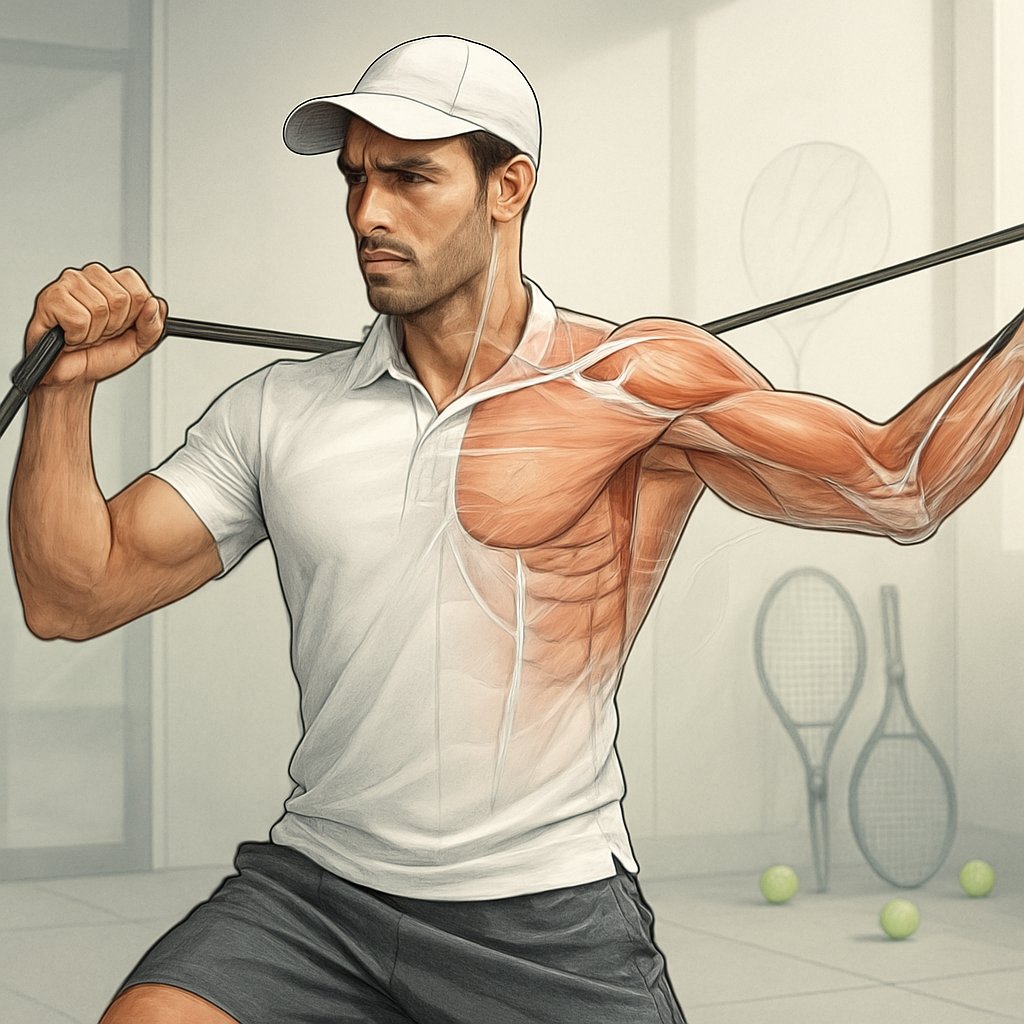
Tennis players need focused exercises to build rotator cuff strength and fix common movement issues. These techniques help prevent internal rotation deficits and improve scapular control.
Rotator Cuff Strengthening and Stability Exercises
Your rotator cuff muscles keep your shoulder stable during tennis strokes. They’re small but mighty, and they need special training to avoid injury.
External rotation exercises are a must for tennis players. Grab a resistance band or light weight and rotate your arm outward from your side.
Prone horizontal abduction targets your posterior deltoid and middle trapezius. Lie face down, lift your arms out to the sides at 90 degrees, and feel the burn.
Scaption raises work your supraspinatus. Lift light weights at about 30 degrees forward from your side, thumbs up.
Do these exercises 2-3 times a week, 2-3 sets of 12-15 reps. Focus on control, not heavy weight.
Improving Scapular Control and Thoracic Mobility
Your scapula needs to move right for your shoulder to stay healthy. Bad scapular control can lead to rotator cuff problems and other shoulder issues.
Wall slides help retrain your scapula. Stand with your back to a wall and slide your arms up and down, keeping them in contact with the wall.
Effective scapular control is part of a comprehensive Tennis Shoulder Injury Prevention plan.
Prone Y-T-W exercises strengthen the muscles that move your scapula. Lie face down and move your arms into Y, T, and W shapes. This hits your middle and lower traps.
Thoracic spine mobility matters too. Foam rolling and stretching your upper back keeps your shoulders from having to work overtime.
Do these exercises before and after tennis to keep your movement patterns sharp.
Addressing Glenohumeral Internal Rotation Deficit
GIRD—glenohumeral internal rotation deficit—means your shoulder loses some internal rotation. It’s common in tennis and raises your injury risk.
Sleeper stretches help restore internal rotation. Lie on your side and gently push your top arm toward the ground. Hold for 30 seconds, repeat a few times a day.
Cross-body stretches target the back of your shoulder. Pull your arm across your body and hold at your elbow.
A physical therapist can check if you have GIRD. Regular stretching keeps this problem from getting worse and helps prevent rotator cuff injuries.
Keep an eye on your shoulder flexibility during the season. If you lose motion, address it quickly before it turns into something bigger.
Recognizing and Managing Shoulder Injuries
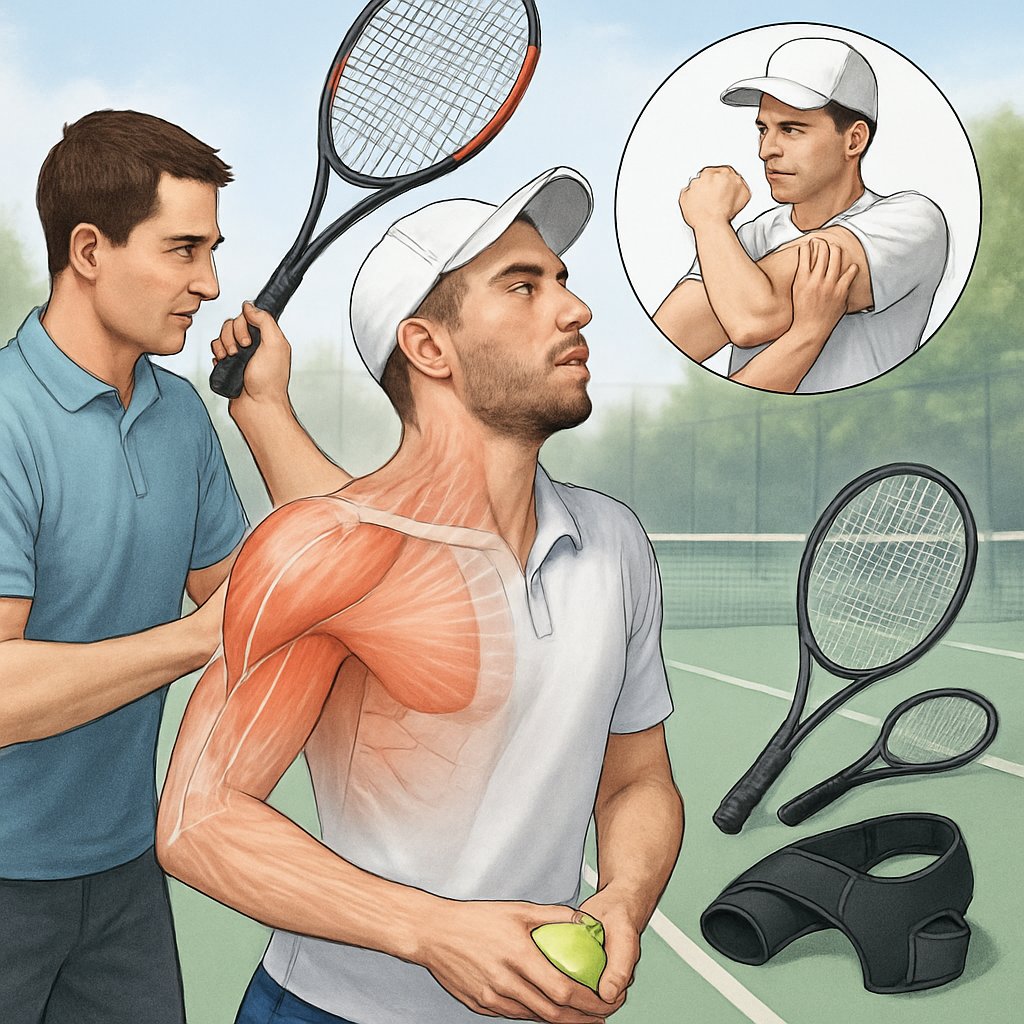
Acting fast when shoulder problems start can keep small issues from becoming big ones that take you off the court. Knowing the warning signs and taking the right steps helps you get back to tennis safely.
Early Signs and Symptoms of Shoulder Dysfunction
Pain during or after serving is usually the first red flag. You might notice aching in your rotator cuff after practice.
Stiffness in the morning or trouble reaching overhead can be warning signs. Your shoulder might feel tight when you try to scratch your back or reach across your body.
Watch for these symptoms:
- Sharp pain during the serve
- Weakness lifting your arm above shoulder height
- Clicking or popping sounds when you move
- Night pain that wakes you up
Partial rotator cuff tears often hurt without causing obvious weakness. Full tears usually mean both pain and noticeable strength loss.
Muscle strains feel like pulling or burning. Labral tears tend to cause deep pain that gets worse with overhead moves.
First-Line Treatment and Rehabilitation Approaches
Take a break from tennis as soon as shoulder pain starts. Ice the area for 15-20 minutes a few times a day during the first 48 hours.
Sports medicine doctors can figure out the exact injury with a physical exam and imaging. Physical therapy usually anchors most shoulder rehab plans.
Initial treatment includes:
- Changing activities to avoid painful movements
- Taking anti-inflammatory meds if your doctor says so
- Doing gentle range of motion exercises
- Starting strengthening when pain lets up
Physical therapy works on restoring shoulder blade control and rotator cuff strength. Your therapist will show you exercises for weak muscle groups.
If you have a severe injury like a full rotator cuff tear, you might need surgery. Procedures range from rotator cuff debridement to biceps tenodesis for certain tendon issues.
Return-to-Play Guidelines for Tennis Athletes
Getting back to tennis means hitting certain physical goals first. You should have a full, pain-free range of motion in every direction before you start playing again.
Strength tests need to show at least 90% of the power of your other shoulder. Your sports medicine crew will check your serve and stroke technique.
Return phases include:
- Start with basic groundstrokes at half effort
- Move to full groundstrokes but skip serving
- Add in easy serving motion practice
- Gradually return to actual match play
If you feel pain during any activity, you’re not ready yet. Trying to rush back just sets you up for another injury and even longer recovery.
Your physical therapist will take you through tennis-specific drills to get your shoulder ready for the game.
Special Considerations and Long-Term Maintenance
Keeping up with Tennis Shoulder Injury Prevention is crucial, especially as you adapt your training over time.
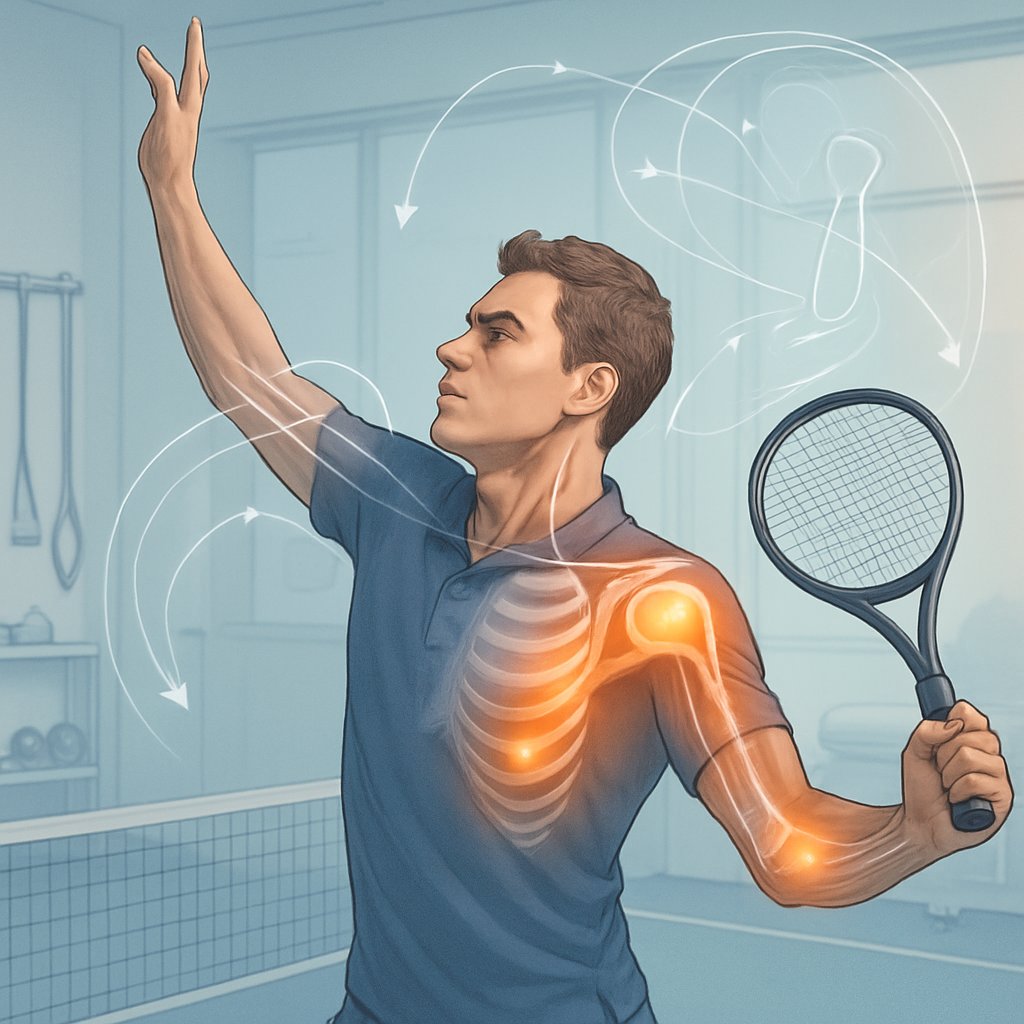
Tennis players need shoulder care that fits their sport’s demands and their own career timeline. Building real shoulder health means adjusting your prevention game as you go and teaming up with people who know what they’re doing.
Prevention for Young and Overhead Athletes
Young athletes face different shoulder risks than adults. Their bodies are still growing, so their training needs extra care.
Growth plates in young players don’t close until their late teens. That makes their shoulders more at risk for overuse injuries.
Key guidelines for young players:
- Limit overhead serving to 2-3 times per week
- Nail proper technique before cranking up the power
- Take regular rest days after tough training
Overhead throwers like baseball pitchers deal with similar shoulder problems as tennis players. Both sports hammer the shoulder joint over and over.
Tennis elbow often links back to shoulder issues in overhead athletes. If shoulder muscles are weak, the elbow picks up the slack during strokes.
Young players should focus more on scapular strengthening. Those muscles are the base for every overhead move in tennis.
Adapting Training for Recovery and Longevity
Your shoulder needs change as you get older and play more. Older players have to tweak their routines to stay in the game.
Recovery just takes longer with age and mileage. What used to take a day might need two or three now.
Training adaptations for longevity:
Long-term shoulder health in tennis requires ongoing Tennis Shoulder Injury Prevention efforts.
- Spend more time warming up before you play
- Add mobility work between sessions
- Cut back on high-intensity overhead stuff during peak season
Old shoulder injuries don’t just go away for good. Lots of players quit their prevention exercises once the pain stops, but that’s risky.
Stick with your maintenance exercises every day—10-15 minutes is enough. It’s the best way to keep future problems at bay.
Pay attention to shoulder fatigue during tournaments. Adjust your training based on how your shoulders feel, not just what’s on the schedule.
Collaborating With Sports Medicine Professionals
Working with good professionals makes a big difference. Physical therapists get what tennis does to your shoulders.
Sports medicine pros can spot movement issues before they turn into injuries. They notice the little compensation habits that add up over time.
When to seek professional help:
- Stiffness that sticks around more than three days
- Pain that messes with your strokes
- Overhead weakness that doesn’t get better with rest
Serious tennis players should get a physical therapy checkup once a year. It’s a smart way to catch small problems early.
A knowledgeable pro can tweak your prevention plan based on your playing calendar. They’ll switch up exercises for tournaments or the off-season.
Keep your healthcare team in the loop about your shoulder. Track any pain or stiffness patterns you notice—don’t just ignore them.
Frequently Asked Questions
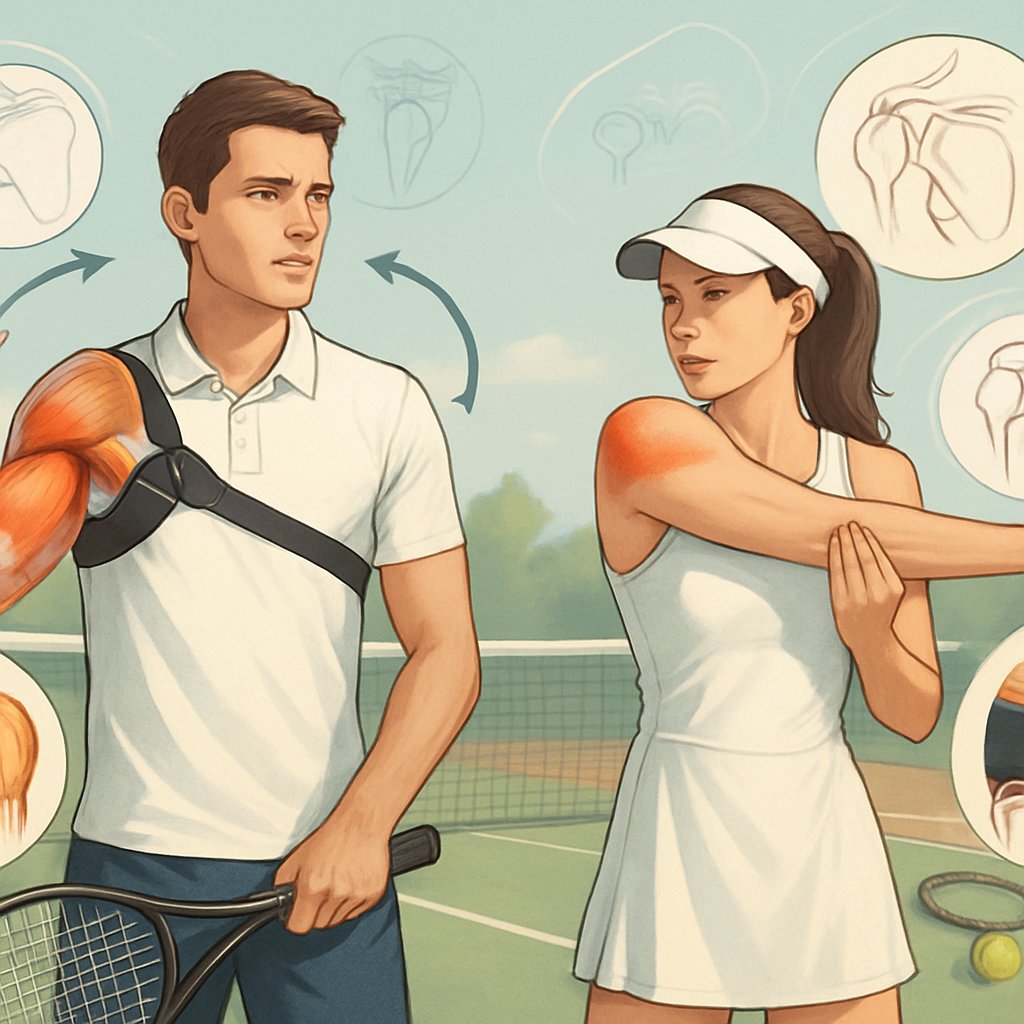
Understanding how to implement effective Tennis Shoulder Injury Prevention strategies will keep your game strong.
Tennis players have to deal with some tricky shoulder issues. These questions cover the best ways to keep your shoulders healthy and your tennis game strong.
What are effective warm-up routines for shoulders in tennis?
Start with arm circles in both directions for about half a minute each. It gets your blood pumping and wakes up those muscles.
Do shoulder blade squeezes—pull your blades together, hold for a few seconds, and repeat about 10 times.
Add arm swings across your body and overhead. That dynamic movement gets your shoulders ready for action.
Wrap up with gentle internal and external rotations. Use your racket or resistance bands to fire up your rotator cuff before you play.
What strength training exercises target shoulders and trunk for tennis players?
Try external rotations with resistance bands to strengthen your rotator cuff. Two sets of 15 reps with light resistance works well.
Shoulder blade rows hit the muscles that keep your shoulder stable. Bands or cables both work.
Planks and side planks build your trunk strength, which supports your shoulders during serves and strokes. Hold them for 30-60 seconds.
Face pulls target the rear deltoids and upper back—great for balancing out that forward shoulder posture tennis creates.
What are the best recovery techniques for shoulder injuries caused by tennis?
Rest is your first move if your shoulder hurts. Stop playing right away to avoid more damage.
Ice the sore area for 15-20 minutes a few times a day in those first 48 hours. It helps cut down swelling and pain.
Gentle range of motion exercises keep your flexibility as you heal. Only move your arm as far as it feels comfortable.
Physical therapy gives you tailored exercises and treatments for your injury. A good therapist will guide your recovery step by step.
Which shoulder injuries are most common among tennis players and how can they be prevented?
Rotator cuff strains hit about a quarter to half of tennis players. Repetitive overhead serves are usually the culprit.
Both players and coaches should prioritize Tennis Shoulder Injury Prevention measures to minimize injury risks.
Shoulder impingement happens when tendons get pinched during arm movements. Poor technique and weak muscles make this more likely.
Prevent problems by warming up right every time you play. Strengthen your rotator cuff and shoulder blade muscles regularly.
Use proper serving technique to lower the stress on your shoulders. If you’re not sure, ask a coach to take a look at your form.
Taking time to learn about Tennis Shoulder Injury Prevention can help you maintain peak performance throughout the season.
What power exercises can help enhance shoulder performance in tennis?
Medicine ball throws boost explosive shoulder power for serves. Throw the ball overhead at a wall or to a partner.
Plyometric push-ups build fast-twitch muscle fibers in your shoulders and chest. If you’re new to these, start with regular push-ups.
Resistance band moves with quick, snappy motions help with power and speed. Focus on external rotations and pulls for best results.
Weighted ball slams work your whole shoulder complex with some serious force. Just make sure your form is solid to avoid injury.
Incorporating power exercises into your training regimen should always align with Tennis Shoulder Injury Prevention goals.
How can tennis players effectively implement cardio into their training for shoulder health?
Swimming’s a fantastic way to get your cardio in while working your shoulders, thanks to all that water resistance. Just make sure you focus on good stroke technique—it’s easy to get sloppy otherwise.
Elliptical machines with arm handles? Those hit both your cardiovascular system and your shoulders at the same time. Try to keep a moderate pace; there’s no need to go wild.
Interval training with bodyweight moves can really boost your fitness and help your shoulders last longer on the court. Toss in some jumping jacks and arm circles for a bit of variety.
Tennis-specific drills, like shadow swings, blend cardio with actual tennis movements. Practice your serves and strokes, even without a ball—it still counts.
Regularly practicing Tennis Shoulder Injury Prevention techniques will lead to a more sustainable and enjoyable tennis career.
